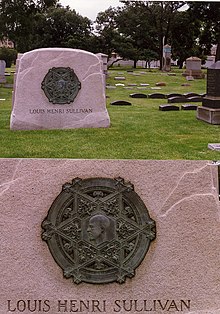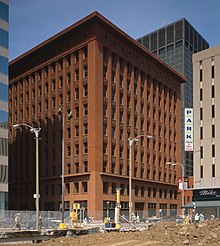Louis Sullivan
Louis Henry Sullivan (born September 3, 1856 in Boston , Massachusetts , † April 14, 1924 in Chicago , Illinois ) was an American architect .
Life
Sullivan moved to Paris after dropping out of his studies at MIT and intermediate stops in New York , Philadelphia in 1873, to continue his studies there at the École des Beaux-Arts . At the same time he was working in the Paris studio of Émile Vaudremer , a supporter of the pioneer of the form-follows-function movement, Viollet-le-Duc . After a short time, however, Sullivan traveled on to Italy and graduated there at the age of 19. He returned to America and worked in the Chicago office of William Le Baron Jenney , known as one of the fathers of the skyscraper . The subsequent collaboration with the German engineer Dankmar Adler led in 1881 to the joint office Sullivan & Adler, which was formative for the so-called Chicago School . Frank Lloyd Wright also worked in this office for five years. The buildings built by Sullivan in the almost 20 years up to the turn of the century became famous and made architectural history. Adler left the office in 1895. Then Sullivan hit another big hit in 1899 with what is probably his most famous work, the Carson Pirie Scott Building department store , which is also known as the Sullivan Center. After the turn of the century, with the time of the Chicago School , Sullivan's professional peak was over.

He also entered the history of architecture and design with a quote from his article The Tall Office Building Artistically Considered in Lippincott's Magazine from 1896: form follows function . Translated logically, this means something like “The shape of a building or an object is derived from its function.” However, he quotes the saying of his partner Dankmar Adler, who in turn had taken it over from Henri Labrouste.
Sullivan died lonely, destitute and severely alcoholic after his star steadily declined over the years of separation with partner Adler. After his poor death, he was buried in the Graceland Cemetery in Chicago with the financial support of Frank Lloyd Wright . Today a memorial stone erected in 1929 commemorates Louis Henri Sullivan. The very simple shape on the one hand is remarkable, on the other hand the "high-rise buildings" carved out on the sides pay homage to the former co-founder of the Chicago school. Later, Frank Lloyd Wright set him a literary monument with his book Genius and the Mobocracy and described himself in it as the “pencil” in the hand of his old “love-master”.
Buildings (selection)
- 1887–1889: Auditorium Building , Chicago
- 1890: The Wainwright Building, St. Louis , Missouri
- 1890: Getty Tomb, Graceland Cemetery , Chicago
- 1890: Kehilath Anshe Ma'ariv Synagogue, since 1922: Pilgrim Baptist Church, Chicago (destroyed by fire on January 6, 2006)
- 1893: World's Columbian Exposition , Transportation Building
- 1894–1895: Guaranty Building, Buffalo
- 1899–1904: Carson, Pirie, Scott Building (Schlesinger and Mayer Department Store), Chicago
Banks
- 1901-1911: People's Savings Bank, Cedar Rapids, Iowa
- 1908: National Farmer's Bank of Owatonna, Owatonna , Minnesota
- 1912: Peoples Savings Bank, Cedar Rapids , Iowa
- 1913: Henry Adams Building, Algona , Iowa
- 1914: Merchants' National Bank, Grinnell , Iowa
- 1914: Home Building Association Company, Newark , Ohio
- 1914: Purdue State Bank, West Lafayette , Indiana
- 1918: People's Federal Savings and Loan Association, Sidney , Ohio
- 1919: Farmers and Merchants Union Bank, Columbus , Wisconsin
Fonts

- The autobiography of an idea. Reprint of the edition published by the American Institute of Architects , New York 1924. Ed. Dover Publications, New York, 1956.
- The tall office building artistically considered. In: Lippincott's Magazine. April 1896.
- Ornament und Architektur (in the original: A system of architectural ornament. 1924). Wasmuth, Tübingen 1990
literature
- William Connely: Louis Sullivan As He Lived. The Shaping Of American Architecture. A biography. Horizon Press, New York 1960.
Movies
- Sullivan's banks (= photography and beyond - part 2 ). Director: Heinz Emigholz , 35 minutes, Germany 1993–2001, 2007 also released on DVD.
Web links
- Literature by and about Louis Sullivan in the catalog of the German National Library
- Louis Sullivan. In: arch INFORM .
- Biography of Louis H. Sullivan
- Louis Sullivan in Great Buildings
- Movie website Sullivan's Banks. Pym Films
- Spotlight: Louis Sullivan at ArchDaily
- Looking after Louis Sullivan. Exhibition at the Art Institute of Chicago , 2010
Individual evidence
- ^ Frank Lloyd Wright: Genius and the Mobocracy . Duane, Sloan and Pearce, New York 1949.
- ^ Transportation Building. In: Photographs of the World's Fair. Werner Co., Chicago 1894, p. 121 ff.
| personal data | |
|---|---|
| SURNAME | Sullivan, Louis |
| ALTERNATIVE NAMES | Sullivan, Louis Henri |
| BRIEF DESCRIPTION | American architect |
| DATE OF BIRTH | September 3, 1856 |
| PLACE OF BIRTH | Boston , Massachusetts |
| DATE OF DEATH | April 14, 1924 |
| Place of death | Chicago |


